Pressure Project 2
Posted: February 7, 2024 Filed under: Uncategorized Leave a comment »Other World was quite an experience, I was intrigued from the start, there was a fractal projection surface outside of the exhibit spaces that I didn’t notice until light hit the surface and revealed the perfectly projection mapped textures on each triangular piece. I knew I was in for a treat.
I was particularly interested in the spaces that felt like a portal and infinite almost like a forest. The room that caught my attention was what I would call the infinite light forest. There were mirrors on all of the walls in the room with poles of light that were about 8 to 10 feet tall and shifted colors. There was also an ambient space like musical track playing from hidden speakers, that sparked a sense of curiosity As I took a closer look there were individual wires above connected to each light for power and signaling the light change. When I first entered the room I thought touching the poles initiated some part of the experience, as I observed, I noticed other folx thought the same. This exhibit turned out to be an ongoing light show that could seemingly go on forever.
People moved in-between the lanes of light and around the light pole fixtures. There was no particular pattern or path for one to take within this experience. I enjoyed how you were able to journey at your own pace to take in the vastness of the moody space.
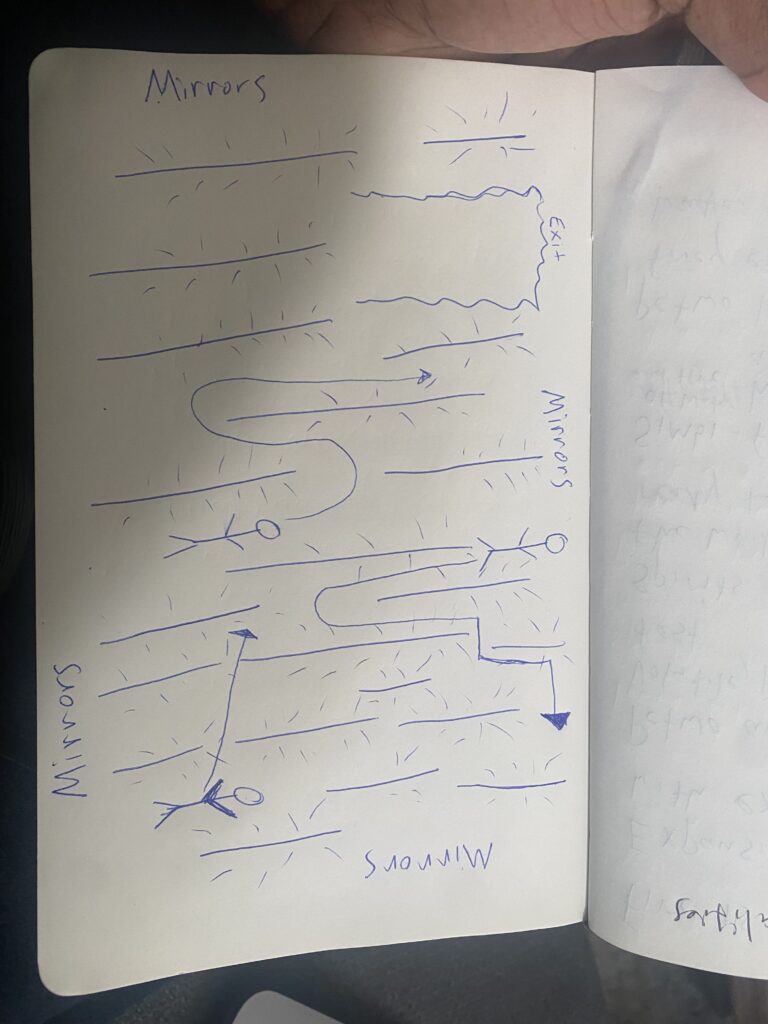
I started to think about how I would reimagine this space if it were my project. I would shift the space into a digital tree forest.

First, I would change all of the light fixtures to trees and keep the mirrors for the infinite effect and add an interactive touch element to the bark that you must stay connected to, to learn facts about native trees in the state. In constructing the space I would source the energy and wires from below like a root system verses above. Second, I would shift the sound in the space to wind blowing through trees and sounds of leaves crunching under your feet. For my last augmentation of the space I would add a motion sensor to active wind/a fan as people move through the space to feel as if they are in a surreal natural environment.
Orlando’s Bumped Article
Posted: January 23, 2024 Filed under: Uncategorized Leave a comment »https://dems.asc.ohio-state.edu/?m=202212
Cycle 3: Sensory Soul Soil
Posted: April 30, 2022 Filed under: Uncategorized Leave a comment »For my cycle 3 project I shifted the soundscape a bit, changed two interfaces and the title. I honed in on two of the growers interviews. I wanted to illustrate the connection to what they’ve grown through an organic interface rather than the former plastic tree. For instance grower Sophia Buggs, started out growing Zucchini in kiddie pools because her grandmother used to make Zucchini bread. Highlighting this history I wanted the participant to feel the electricity Sophia and her grandmother felt with hands in the soil and on fresh zucchini. I worked with my classmate Patrick to clean the sound of Sophia’s interview because when I interviewed her we were in a noisy restaurant. He worked with me to level the crowd in the background and amplify Sophia’s voice to the foreground. I used two tomatoes to illustrate grower Julialynn’s expression “It was just me and two tomatoes!”. This is her origin story to growing her church’s community garden. Sensory Soul Soil in an experiment of listening with your hands, feeling your body, and seeing with your eyes and ears.
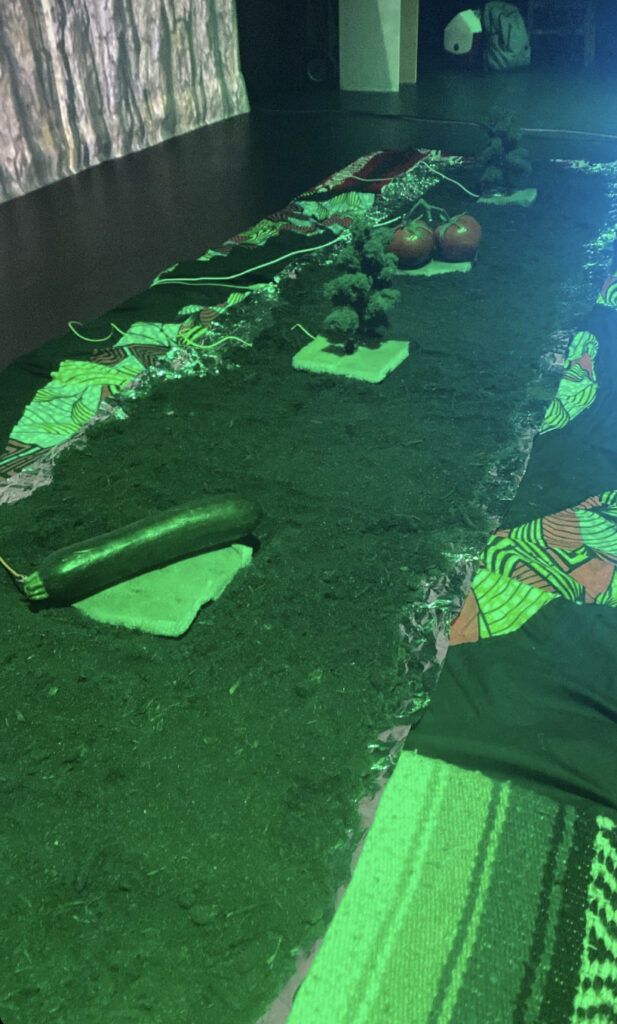
As for the set up I decided to start in front of the sensory soil box. I made this change so that I can better guide the participate in the experience. This go round I wanted to bring some color to the originally white box. I used Afro-Latinadad fabric to build in a sense of cultural identity through patterns and colors also representing those who have labored in our U.S. soil.
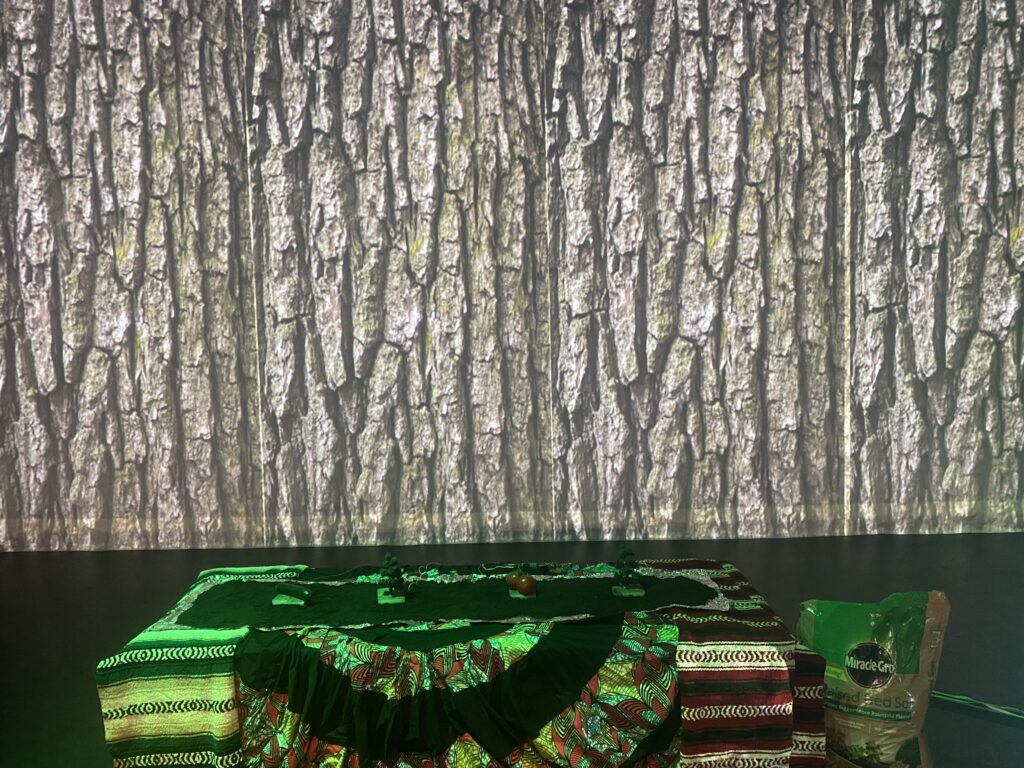
In the last iteration I didn’t really know how to bring the space to a close however within this cycle I closed the space with a charge to join the agricultural movement by getting involved anyway they can because the earth and their bodies will appreciate it. This call to action is and invitation to take this work beyond the performative, experiential space, and in to the world from which this inspiration came.
To get my sound to work the way I intended, I designed the trigger values and gates to be able to start the audio when touched and cut off when you are not connected. I found that having wav files for sound works better in the sound player. My MP3 continued to show in the movie player just an FYI.
Below you can see one of the Sensory Soul Soil experiences with Juilalynn and two tomatoes.
In the video below you will witness how I curated the space to be extremely immersive. My goal was to engage in the true labor of a grower not only by hearing their stories but also by embodying their movement. I changed the title because now all materials in this iteration are tress as before. I figured sense I come a culture of soul food, and food has the nutrients to feed the soul which comes from the soil why not call it what it is. A Senory Soul Soil experience.
Cycle 2 “If trees could talk, What would they say?”
Posted: April 21, 2022 Filed under: Uncategorized Leave a comment »In cycle two I wanted to take the experience to a larger scale. I added two more trees to the Makey Makey and worked with my classmate Patrick and instructors Oded and Alex to work on the sound aspect which I was most concerned with during this cycle. We configured the four interviews to come from four individual speakers in the motion lab by creating four channels of sound in Isadora.
Below is an image of what I imagine to be a “raised bed” and row of electric soil of connectivity.
I used aluminum foil to create a more conductive grounding for the soil.
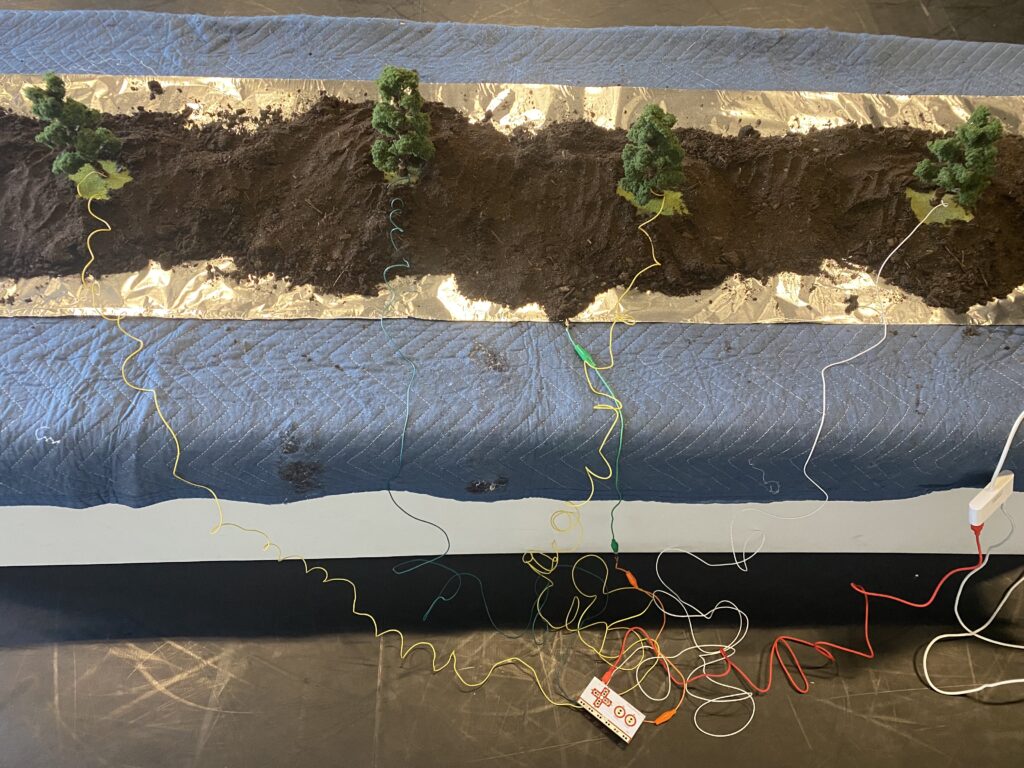
I learned how to build a gate to trigger each of the sound players so that when participants are not connected to the tree and the soil the audio nor the image of the growers will appear.
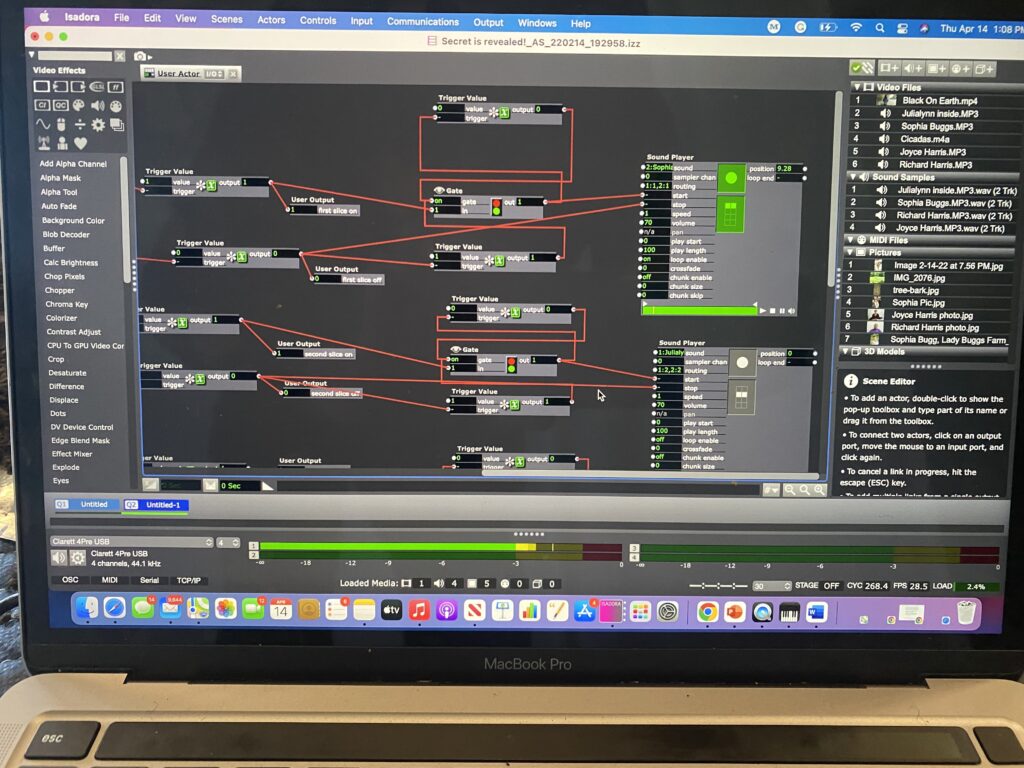
I chose to keep the raised bed box closer to the screen so that participants could have the feeling of looking up at the trees. My goal was to honor the wisdom coming from Black growers through bringing awareness to trees and how important their communication systems are complex yet work together underneath the soil.
I curated the green lighting, with two identical images of an urban garden on scrims that made a half circle in the space to give participants the feeling that they were truly in the thick of a green space. For African diasporic folx greenery has been a mode of protection and healing through imperial, capitalist empires that often destroy these types of environments for their own social gain.
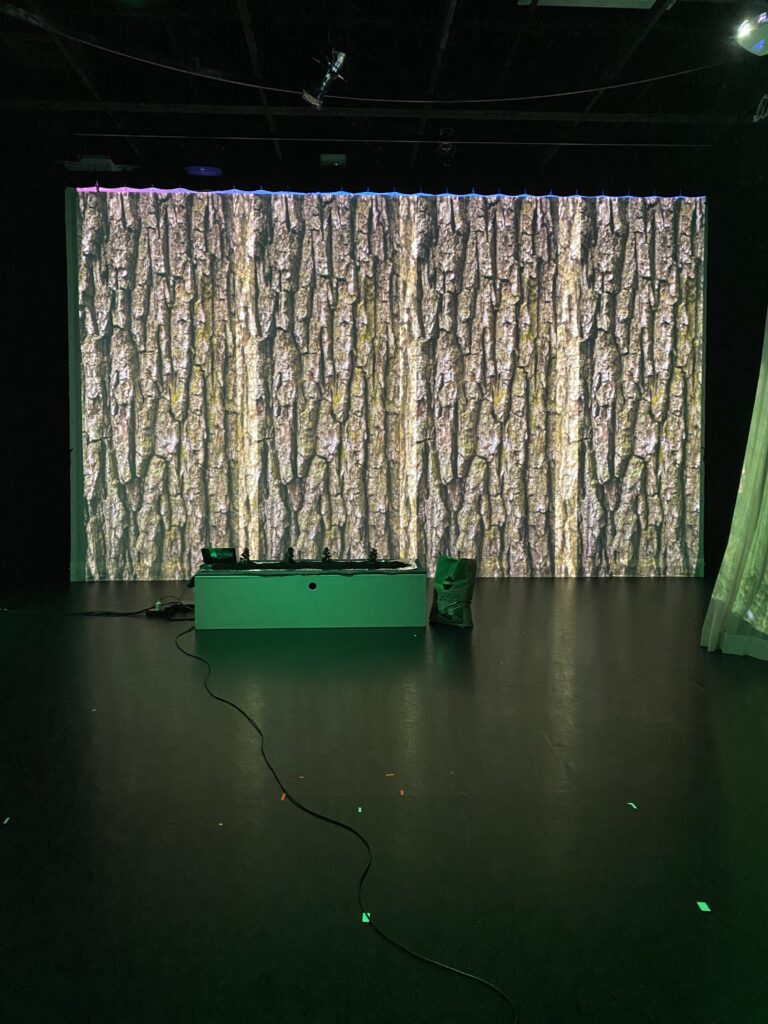
In this iteration, I wanted to get people to move with me. Folx living in urban areas barely make time for cooking let alone be in a garden working. I want the participants to embody what it feels like to take on some of the labor of what it means to grow your food. Kneeling at the raised bed or pulling weeds, and even harvesting vegetables from the garden are often tough on the back and knees. This kind of labor is seen as servitude in this country. I invite the participants to join me as I do the work. In the 21st century, Black bodies are reclaiming our right to acquire land and provide quality food for our communities.
During this cycle I realized that participants needed a little more incentive to be invited into the space. As a performer I understand that a non-traditional performance asks participants to negotiate how to engage the space. At the beginning introduction, I gave clear instructions on how to engage with the space however once I started to move it was almost as if the participants didn’t want to move because they wanted to pay attention to me.
I figure for cycle 3 I will change my position in the room. It was suggested that I start in front of the raised bed to orient where the main engagement is, do my introduction, and then dance from in front of the screen providing a gesture of invitation into the experience.
Pressure Project #3 Audio
Posted: April 20, 2022 Filed under: Uncategorized Leave a comment »Unfortunately I was too into the experience to record however, I created an audio ecomemory of corn. Ecomemory is a term coined by Melanie L. Harris in her book Ecowomanism. I wanted to illustrate through sound my African American experience with corn. In this Audio project, I wanted to integrate movement, agriculture and technology. I love to layer sounds to create stories. To begin I placed Aretha Franklin’s Spirit in the dark as the base sound to provide soul and evoke spirit. I used my voice to give a brief history of Henry Blair the inventor of the corn planter, I also layered a recording of Micheal Twitty an African-American Jewish writer, culinary historian, and educator. He is the author of The Cooking Gene.
He sings a song called the “Whistling walk“. This was a song sung by enslaved folks when they walked down a walkway connected to the big house to serve food to indicate that they were not eating the food. This was layered with the sound of barking dogs with me saying ” hush puppy hush, hush puppy hush”. Hush puppies are made from corn meal and got their name because enslaved folks who liberated themselves would use these corn meal fried delights to keep dogs quite and off their trail. I then added my grandmother’s voice telling a story of her father and how they grew corn on his land. To close I ended with Micheal Twitty in his reconstructed version of the “Whistling walk” he sang, “no more whistling walk for me no more, no more. No more whistling walk for me many thousands gone.” This reconstructed song reclaims African American food labor for future generations who grow and work with food to heal as well as honoring those who had to suffer under chattel slavery.
As the audio played, for the movement aspect I passed around a picture of Henry Blair, a photo of my grandmother hugging me, a can of creamed corn, corn meal mix, and a whole ear of corn. These physical object served as tools of embodiment. I wanted the participants to actively listen, literally, by passing the objects around this put not only my personal memory in motion but also created new memories while evoking past memories. Sankofa is a Ghanaian proverb meaning looking back to go forward, go back and fetch it.
Below are a few photos of my classmates and Alex (the instructor of the course) holding the memory technology.
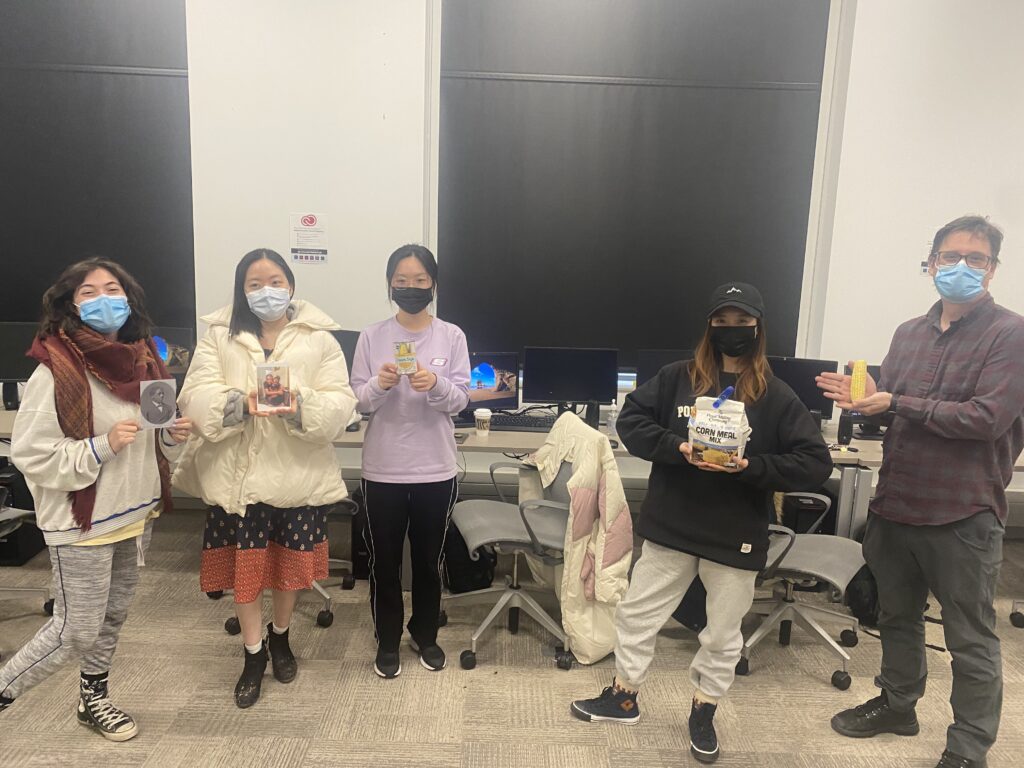

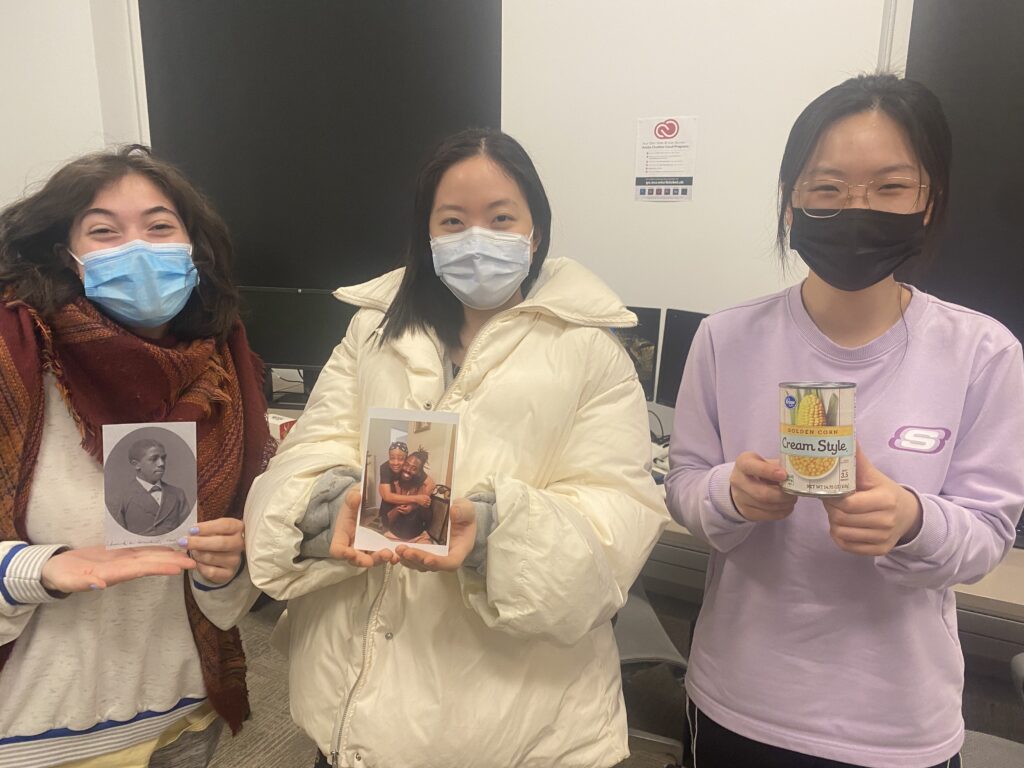
Cycle 1 Project
Posted: April 10, 2022 Filed under: Uncategorized Leave a comment »For my cycle 1 project I wanted to keep with the element of reveal. My intrests live in earth wisdom and agricultural knowledge rooted in the unseen. Within this iteration of the project I wanted to reveal some of the gems the Black growers in my community are graciouly sharing through interviews with me. My graduate studies are based in bridging dance, agricultural, and technology (D.A.T). I am working from a quote from Nikki Giovanni “If trees could talk what would they say?”
I am continously insired by the soil and its ability to generate life, transmute energy and produce healing to humans. The soil in this work is central to the grounding for the entire experience. My goal is to connect and ground the participant in the moment to be present with the images and the knowledge provided by the growers.
My set up consists of the Makey Makey, soil, and two tree models for the participates to touch indicating the wisdom held in trees/people in my community. I wrapped brown pipe cleaners around the interior of the plastic “tree bark” to conduct an eletrical current to set off the digital engagemet with the Makey Makey. As participants touch the bark of the tree model, their hand must be grounded, touching the soil. This connection reveals an image of the growers and activates the interviews.
I realized in this cycle I needed to cut the interviews down to about 30 seconds each because I imagine this as a gallery installation. I watched the bodies in the room shift and kind of zone out as they tried to listen to the stories being told. Audio seems to be key for the experience to translate how I intend. I would like the experience to be so that the participate knows when the experience begins and ends. I got feedback that there should be a more engaging componet. This comment came from a dancer which I agree. In the future I plan to work with the kinetic sensor to provide a movement based engagement for the participants to embody agricultural knowledge to evoke ecomemories. For my second cycle I plan to project four growers and their stories. I would like to add two more trees and create an environment where each grower can be heard and engaged with simultaniously in a green space.
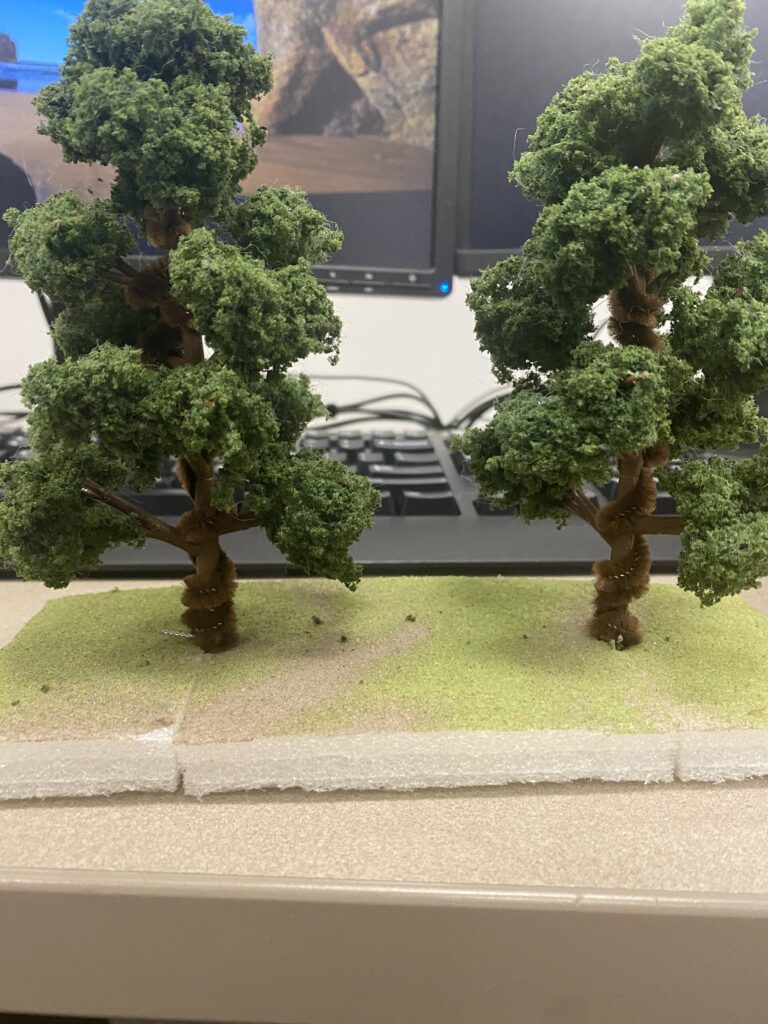
Here are the inner workings of my Isadora patch.
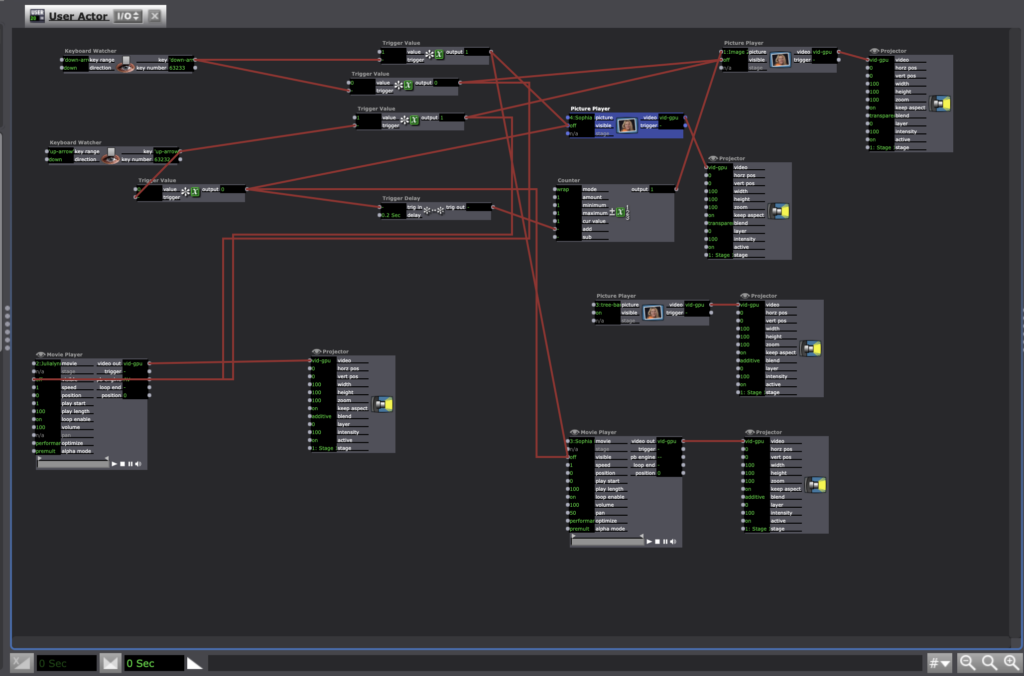
Pressure Project #2- Orlando Hunter
Posted: February 22, 2022 Filed under: Uncategorized Leave a comment »Pressure project #2
For pressure project two I thought about how to incorporate my artistic practice using a dance film created in an urban garden with my dance collective Brother(hood) Dance! In order to create a revealing element within the film I wanted to use photography to illustrate urban growers in the community. To provide sensory awareness to the earth I engage participants by placing their left hand in moist soil to literally ground them in the moment. While lifting the leaf of a plant to reveal photos on the screen and picking up an apple to remove the photo all while the film plays as background, lift the leaf, surprise! Another photo. You only get the surprise if you stay grounded.
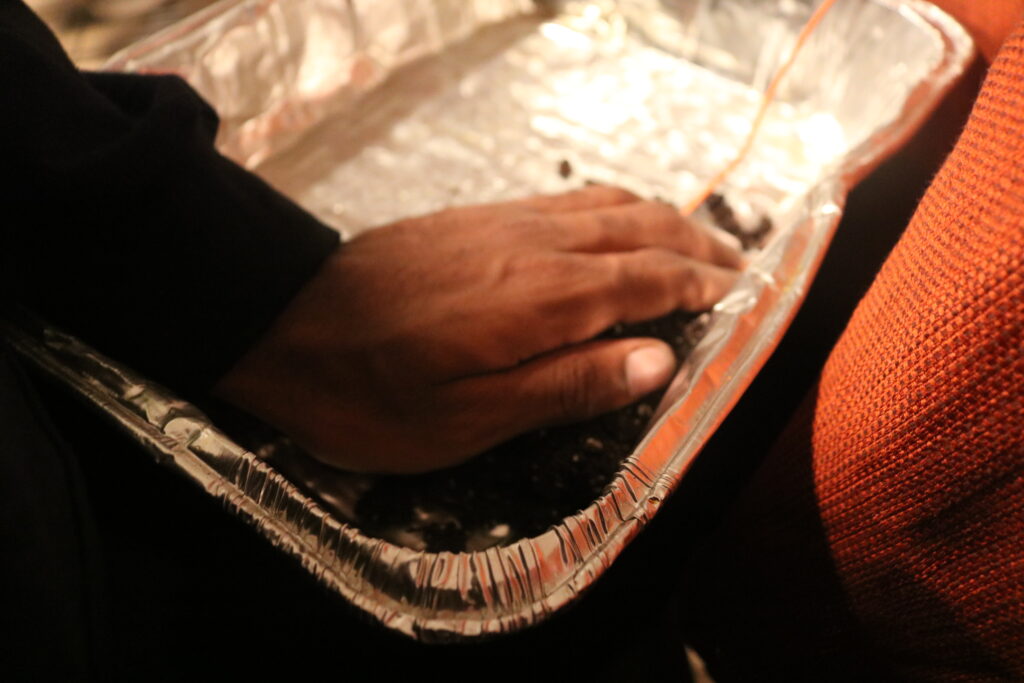
Keep your left hand on the soil.
Pick up the apple for nutrition.
lift the leaf for relief.
Always leave on a high note.

Using the Makey Makey I curated the moist soil to connect to the literal earth on the device which serves as an electronical grounding for the full experience. The apple as the down arrow symbolizing the digestive process which is a downward process to revealing the picture on the screen to illustrate those who grow the nutrition in my neighborhood and the up arrow indicating how house plants give you an upward boost in your wellness from mental to spiritual health.
On the front end I have a movie player playing the dance film. To keep the back end hidden I used a user actor. In the user actor I conducted the change of pictures circuit by using a keyboard watcher to indicate up and down. Then I needed to trigger these functions which in this case up equals plant leaf and down equals apple, soil equals. I had to shift the value for the down arrow so that Isadora knows to signal the photos onto the screen. I also created a trigger delay so that the up arrow would know to switch out photos a specified time within the picture player.

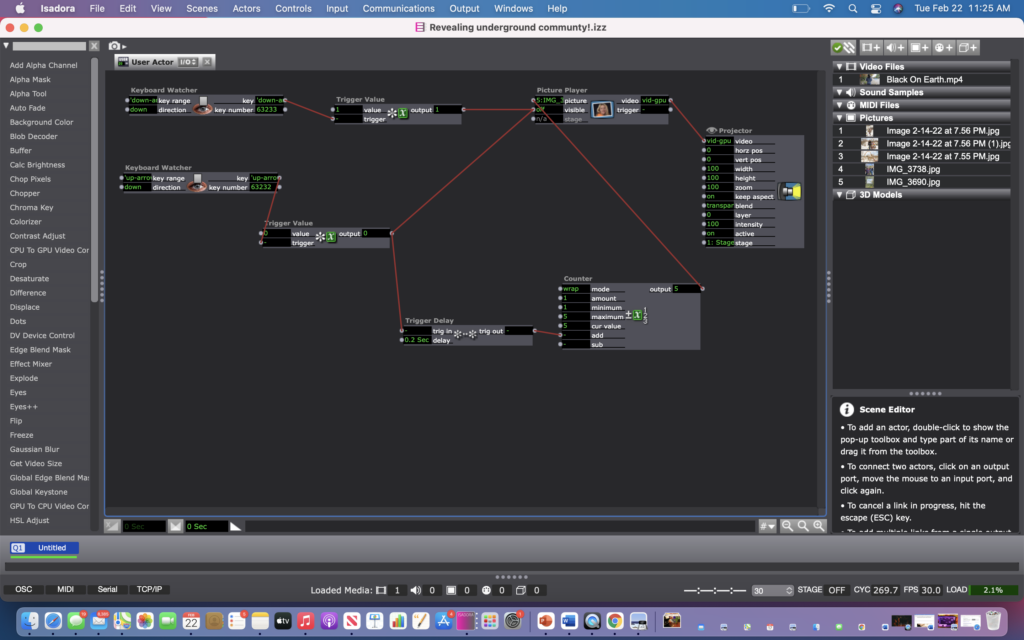
Pressure Project 3 Bump
Posted: January 24, 2022 Filed under: Uncategorized Leave a comment »The digital storytelling in this project caught my attention. The enthusiasm in his voice kept me engaged wanting to know more on prohibition. The still images gives the viewer time to take in the story being told as well as hold the visual context for the narrative. I also enjoy cocktails! https://dems.asc.ohio-state.edu/?p=2924&trashed=1&ids=158